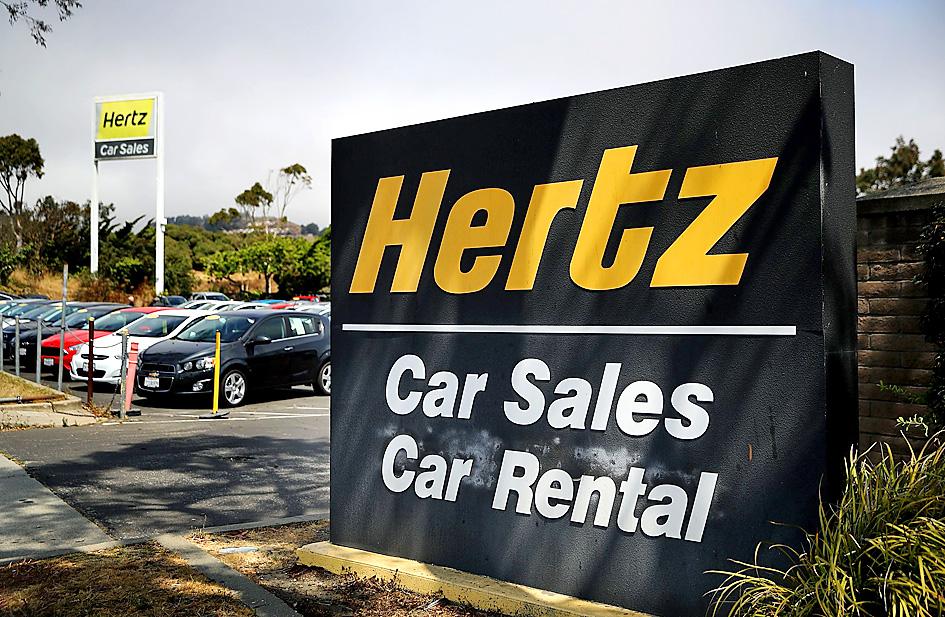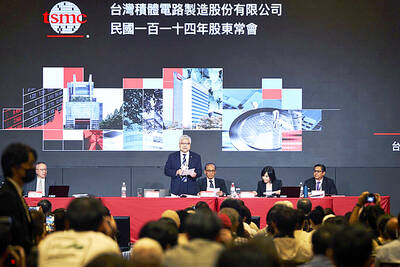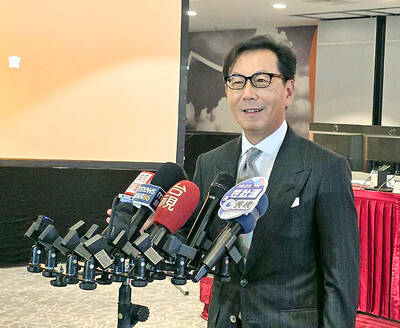From the customer’s perspective, car rental is a straightforward business. The only uncertainty is whether the hire company will charge you for the scratch they discover when you hand back the vehicle.
Hertz Global Holdings Inc’s bankruptcy protection filing on Friday last week was a reminder that today even the simplest business models are underpinned by a lot more financial complexity than meets the eye.
The proximate cause of Hertz’s demise was of course the sudden collapse in bookings caused by COVID-19 travel restrictions. The company’s monthly revenue last month fell 73 percent year-on-year, a shortfall that even the most resilient companies would struggle to withstand for long.

Photo: AFP
However, Hertz’s complicated financial plumbing contributed to it becoming one of the most high-profile companies to seek protection from creditors during the pandemic.
In the decade preceding its collapse, Hertz took on too much debt, participated in overpriced mergers and acquisitions, and was accused of playing accounting games to pad its earnings.
So when disaster struck and a request for a government bailout was rejected — rightly in my view considering the top shareholder, Carl Icahn, is worth about US$18 billion — Hertz was already standing far too close to the precipice. Regrettably, COVID-19 will probably expose more of this type of corporate frailty, both in the US and around the world.
Hertz’s debt binge began when it was acquired by private equity firms from Ford Motor Co in 2005; the new owners quickly took out a US$1 billion dividend. Piling on debt juiced the potential returns for the owners and helped pay the inflated US$2.3 billion price tag for the Dollar and Thrifty brands in 2012, which Hertz struggled to integrate.
Hertz was only able to amass an eye-watering total of US$19 billion in borrowings thanks to a massive program of asset-backed lending, which became its primary source of capital.
LEASE AND RENT OUT
Special-purpose financial entities purchase vehicles on Hertz’s behalf and investors in the asset-backed securities make a return via the lease payments that Hertz is obliged to stump up. Put another way, Hertz leases vehicles long-term from the financing subsidiary — typically for about 18 months in the US — and then rents them out to customers for shorter periods.
In theory, this is a stable and low-cost way for a risky borrower, such as Hertz, to fund the large capital outlays needed to keep its fleet looking fresh.
Hertz’s corporate credit has been rated junk for the past decade, but many of the asset-backed securities it issued were triple-A rated, at least until recently.
However, economic shutdowns stemming from efforts to curb the novel coronavirus suddenly threw a lot of sand in Hertz’s gears: The resale value of its vehicles fleet fell sharply, requiring the company to inject more cash into the financing structure.
With only about US$1 billion of cash on its books, Hertz was ill-placed to fund that collateral call, and the pandemic meant it was not able to sell vehicles to generate cash, because potential buyers were confined to their homes and auctions and dealerships were closed.
Asset-backed securities holders appear to have decided that allowing Hertz to fall into bankruptcy would prove no impediment to them getting most of their money back, at least for those holding the better-rated tranches of debt.
However, the same cannot be said for Hertz’s unsecured lenders, or its shareholders. Building a 39 percent stake since 2014 probably cost Icahn about US$1.6 billion, based on a Bloomberg average share-cost estimate, but he now risks being wiped out.
Hertz’s predicament was made more severe, because in the US it could not hand back most of its surplus vehicles to the manufacturer, as is common practice in Europe. Instead, it faced the task of selling them itself and bore the risk of any unexpected depreciation. The firm is one of the 10 largest sellers of used vehicles in the US.
The preponderance of these so-called “risk vehicles” in its 500,000-strong US vehicle fleet has increased since 2014, because it was more profitable than paying a premium to the manufacturer to guarantee a fixed repurchase price. There is no reward without risk, though, as Hertz’s bankruptcy filing made abundantly clear.
Having lost money in three of the past four years, Hertz did seem to have turned a corner lately: It raised capital to pay down debt last year and was ranked No. 1 for customer satisfaction in J.D. Power’s North American car rental rankings.
Not that customers have much choice. Consolidation has given just three groups — Hertz, Enterprise Holdings Inc and Avis Budget Group Inc — control of almost the entire US market for airport car rentals.
New competition from ride-hailing companies and a litany of management missteps meant Hertz never achieved the pricing power that Icahn and other recent investors probably assumed would come from all that merger activity.
Because the industry’s fortunes are so closely tied to air and business travel, car rental demand is likely to remain weak for a while.
Still, Hertz remains open for business and thanks to the more lenient Chapter 11 process it should get another chance to make a success of that oligopoly, albeit as a smaller company with different shareholders and a new capital structure.
Chris Bryant is a Bloomberg Opinion columnist covering industrial companies. He previously worked for the Financial Times.
This column does not necessarily reflect the opinion of the editorial board or Bloomberg LP and its owners.

CAUTIOUS RECOVERY: While the manufacturing sector returned to growth amid the US-China trade truce, firms remain wary as uncertainty clouds the outlook, the CIER said The local manufacturing sector returned to expansion last month, as the official purchasing managers’ index (PMI) rose 2.1 points to 51.0, driven by a temporary easing in US-China trade tensions, the Chung-Hua Institution for Economic Research (CIER, 中華經濟研究院) said yesterday. The PMI gauges the health of the manufacturing industry, with readings above 50 indicating expansion and those below 50 signaling contraction. “Firms are not as pessimistic as they were in April, but they remain far from optimistic,” CIER president Lien Hsien-ming (連賢明) said at a news conference. The full impact of US tariff decisions is unlikely to become clear until later this month

GROWING CONCERN: Some senior Trump administration officials opposed the UAE expansion over fears that another TSMC project could jeopardize its US investment Taiwan Semiconductor Manufacturing Co (TSMC, 台積電) is evaluating building an advanced production facility in the United Arab Emirates (UAE) and has discussed the possibility with officials in US President Donald Trump’s administration, people familiar with the matter said, in a potentially major bet on the Middle East that would only come to fruition with Washington’s approval. The company has had multiple meetings in the past few months with US Special Envoy to the Middle East Steve Witkoff and officials from MGX, an influential investment vehicle overseen by the UAE president’s brother, the people said. The conversations are a continuation of talks that

CHIP DUTIES: TSMC said it voiced its concerns to Washington about tariffs, telling the US commerce department that it wants ‘fair treatment’ to protect its competitiveness Taiwan Semiconductor Manufacturing Co (TSMC, 台積電) yesterday reiterated robust business prospects for this year as strong artificial intelligence (AI) chip demand from Nvidia Corp and other customers would absorb the impacts of US tariffs. “The impact of tariffs would be indirect, as the custom tax is the importers’ responsibility, not the exporters,” TSMC chairman and chief executive officer C.C. Wei (魏哲家) said at the chipmaker’s annual shareholders’ meeting in Hsinchu City. TSMC’s business could be affected if people become reluctant to buy electronics due to inflated prices, Wei said. In addition, the chipmaker has voiced its concern to the US Department of Commerce

STILL LOADED: Last year’s richest person, Quanta Computer Inc chairman Barry Lam, dropped to second place despite an 8 percent increase in his wealth to US$12.6 billion Staff writer, with CNA Daniel Tsai (蔡明忠) and Richard Tsai (蔡明興), the brothers who run Fubon Group (富邦集團), topped the Forbes list of Taiwan’s 50 richest people this year, released on Wednesday in New York. The magazine said that a stronger New Taiwan dollar pushed the combined wealth of Taiwan’s 50 richest people up 13 percent, from US$174 billion to US$197 billion, with 36 of the people on the list seeing their wealth increase. That came as Taiwan’s economy grew 4.6 percent last year, its fastest pace in three years, driven by the strong performance of the semiconductor industry, the magazine said. The Tsai